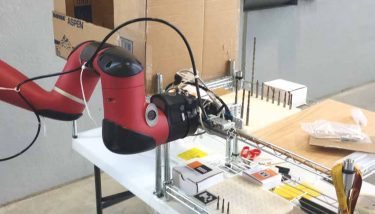
Multiple times each day, the skilled workers at Miracle Tools America in Davenport must stop what they’re doing and clean. Making drill bits can be a dirty business, and the tiny water channels that keep tools from overheating have a tendency to clog.
Hence, the company decided to begin experimenting with a new type of employee—one that wouldn’t mind the monotony.
One made out of metal.
Miracle Tools America expects later this year to begin using a collaborative robot to save time for its human workers and make the overall plant more productive. The “cobot” is being installed after an untrained CIRAS engineering student— someone with no particular expertise in robotics—spent three months learning how to program it.
“I’m very excited about the technology,” said company president Ryan DeBarr. “The flexibility that it will give us down the road will be huge.”
Miracle Tools bought the robot in fall 2017, shortly before an engineer slated to oversee the project left the company. The machine sat unused until DeBarr agreed to an experiment: CIRAS hired McKinley Spading, a senior majoring in mechanical engineering at Iowa State University, to program the machine and get it ready for duty.
For DeBarr, the introduction of cobots is a way to reduce the estimated 40 to 50 hours per week that Miracle Tools America employees currently spend simply blowing the gunk out of what they’re trying to produce. Now, that task only involves setting tools in front of the cobot and pressing its arm as a signal to get to work.
“We’re trying to be more efficient and make the most efficient use of our people’s time instead of paying someone to stand and put tools in this little water nozzle all day long,” DeBarr said. He added that Iowa’s workforce shortage means more automation is inevitable to help with other, similarly monotonous duties at the plant. “If I have a job that’s more crucial, I’d rather have my human employees working on that instead of this.”
For Spading, the project proves that modern industrial robots live up to their billing in terms of being cheaper and easier to operate than ever before.
“Definitely, anybody can pick this up and get 80 percent of the way to where they want to be,” Spading said. “The last 20 percent may take somebody with a little more technical background to understand what tweaks need to be made.“
> For more information, see the Digital Manufacturing Lab story. Or contact Abhay Grover at agrover@iastate.edu or 515-509-1485.
A version of this article was published in the Spring 2019 edition of CIRAS News. To read more of that edition or others, please explore elsewhere on our website.